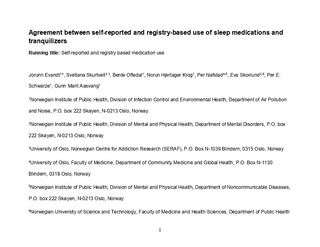| dc.contributor.author | Evandt, Jorunn | |
| dc.contributor.author | Skurtveit, Svetlana | |
| dc.contributor.author | Oftedal, Bente Margaret | |
| dc.contributor.author | Krog, Norun Hjertager | |
| dc.contributor.author | Nafstad, Per | |
| dc.contributor.author | Skovlund, Eva | |
| dc.contributor.author | Schwarze, Per Everhard | |
| dc.contributor.author | Aasvang, Gunn Marit | |
| dc.date.accessioned | 2019-11-14T11:56:31Z | |
| dc.date.available | 2019-11-14T11:56:31Z | |
| dc.date.created | 2019-09-12T21:51:19Z | |
| dc.date.issued | 2019 | |
| dc.identifier.citation | Pharmacoepidemiology and Drug Safety. 2019, 1-8. | nb_NO |
| dc.identifier.issn | 1053-8569 | |
| dc.identifier.uri | http://hdl.handle.net/11250/2628527 | |
| dc.description.abstract | Purpose
The purpose of the present study was to assess the agreement between self‐reported use of sleep medications and tranquilizers and dispensed hypnotics and anxiolytics.
Methods
Self‐reported medication use was obtained from the population‐based survey Health and Environment in Oslo (HELMILO) (2009‐2010) (n = 13 019). Data on dispensed hypnotics and anxiolytics were obtained from the Norwegian Prescription Database (NorPD). As measures of validity, we calculated sensitivity and specificity using both self‐reports and prescription records as the reference standard. Furthermore, we calculated Cohen's kappa. Current self‐reported medication use was compared with prescription data in time windows of both 100 and 200 days preceding questionnaire completion.
Results
The highest sensitivity was observed for current sleep medication use in the 100‐day time window (sensitivity = 0.76, 95% confidence interval [CI]: 0.74, 0.79) when using prescription records as the reference standard. Sensitivity was generally lower for tranquilizers compared with sleep medications. Cohen's kappa showed the highest agreement for the 200‐day time window with substantial agreement for sleep medications (kappa = 0.64; 95% CI: 0.62, 0.67) and moderate agreement for tranquilizers (kappa = 0.45; 95% CI: 0.41, 0.48).
Conclusions
The present study suggests moderate to substantial agreement between self‐reported use of sleep medications and tranquilizers and dispensed drugs in a general adult population. The magnitude of agreement varied according to drug category and time window. Since self‐reported and registry‐based use of these drug classes does not match each other accurately, limitations of each data source should be considered when such medications are applied as the exposure or outcome in epidemiologic studies. | nb_NO |
| dc.language.iso | eng | nb_NO |
| dc.publisher | Wiley | nb_NO |
| dc.title | Agreement between self-reported and registry-based use of sleep medications and tranquilizers | nb_NO |
| dc.type | Journal article | nb_NO |
| dc.type | Peer reviewed | nb_NO |
| dc.description.version | acceptedVersion | nb_NO |
| dc.source.pagenumber | 1-8 | nb_NO |
| dc.source.journal | Pharmacoepidemiology and Drug Safety | nb_NO |
| dc.identifier.doi | 10.1002/pds.4854 | |
| dc.identifier.cristin | 1724256 | |
| dc.description.localcode | Locked until 13.8.2020 due to copyright restrictions. This is the peer reviewed version of an article, which has been published in final form at [https://doi.org/10.1002/pds.4854]. This article may be used for non-commercial purposes in accordance with Wiley Terms and Conditions for Self-Archiving. | nb_NO |
| cristin.unitcode | 194,65,20,0 | |
| cristin.unitname | Institutt for samfunnsmedisin og sykepleie | |
| cristin.ispublished | true | |
| cristin.fulltext | postprint | |
| cristin.qualitycode | 2 | |
